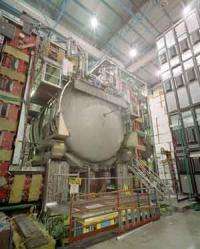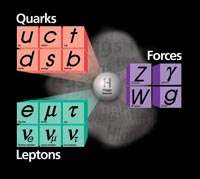Hunt for Higgs boson: Mass of top quark narrows search

(PhysOrg.com) -- New high-energy particle research by a team working with data from Fermi National Accelerator Laboratory further heightens the uncertainty about the exact nature of a key theoretical component of modern physics -- the massive fundamental particle called the Higgs boson.
Analysis of data from particle collisions resulting in two leptons helps improve measurements of the mass of another heavy subatomic particle called the top quark, says physicist Robert Kehoe at Southern Methodist University, who led the team that calculated the measurement. Improving the measurement of the mass of the top quark bears on the nature of the Higgs, says Kehoe, an assistant professor in SMU's Department of Physics.
The Higgs was postulated in the 1960s to help explain how basic elements of the universe fit together and interact. It is responsible for a phenomenon called the Higgs mechanism, which gives mass to the fundamental particles of nature. Physicists have searched for more than four decades to observe the never-before-seen Higgs. Now they hope it will be observed in the next few years since data started flowing recently from the world's newest and largest high-energy particle accelerator, the CERN Large Hadron Collider near Geneva, Switzerland.
Physicists theorize that the top quark — because of its sizable mass — is sensitive to the Higgs and therefore may point to it. They theorize that knowing the mass of the top quark narrows the range of where the Higgs will be detected in CERN's LHC collisions. The top quark is one of 16 species of subatomic particles that physicists have observed. It was predicted in the 1970s and observed in 1995. Increasingly precise measurements of its mass have been achieved almost every year since, and physicists closely watch the incremental measurements of the top quark.
The two-lepton analysis by Kehoe and SMU post-doctoral researcher Peter Renkel looked at data taken over four years during high-energy collisions at Fermilab, a Department of Energy proton-antiproton collider in Batavia, Ill. The two-lepton analysis is one of almost a dozen analyses of the mass of the top quark at a Fermilab experiment called DZero." The DZero experiment involves 500 physicists and is one of Fermilab's two large experimental collaborations of scientists. The top quark mass was first observed simultaneously by these two experiments. Several measurements of the top quark's mass from these two experiments are combined to a "world average" value.
The two-lepton analysis contributed to the latest world average measurement. The analysis looked at particles resulting from smashing protons that break apart and disintegrate. The events are very rare, and the detector can't see two of the important "ghost" particles — neutrinos — produced by the collision. However, the two leptons are well-measured events and are not seen in other "background" collisions where top quarks are not produced. This allows a rapidly improving precision to be achieved.
The two-lepton research was published in November in the article "Measurement of the top quark mass in final states with two leptons" in Physical Review D, the American Physical Society's journal of particles, fields, gravitation and cosmology. SMU physicists collaborated on the research with scientists at Boston University. The SMU portion of the work was funded by the Department of Energy.

The new world average is so precise that it constrains more tightly than ever the range of possible measurements for the mass of the Higgs, Kehoe says. If the Higgs does prove different than currently expected, physicists may have to rework their long-standing theoretical framework, known as the Standard Model. Scientists worldwide are hoping to validate the Standard Model — which has worked well for more than 30 years to explain everything from radioactivity to computer chips — by actually observing the Higgs.
"The new results may be an indication that the Higgs boson has different properties than the Standard Model indicates," Kehoe says. "It's very difficult to devise a theory without some mechanism that mimics fairly well the Higgs mechanism. But if the underlying cause of this mechanism is significantly different, that will have a major impact on the fundamentals of the Standard Model. It could point to something deeper than the standard Higgs boson at work, and that is very interesting."
The measured value of the top quark mass may even go beyond constraining the standard Higgs. It may suggest that our current understanding of the Higgs is not correct, he says.
If the Higgs does not show up where the constraints indicate, the top measurement may force consideration of new theoretical possibilities that lie outside the existing Standard Model, Kehoe says.
Previous measurements have put the top quark at almost the mass of a gold atom. The new world average measurement puts the top quark at about 186 times the mass of the proton. While the value has changed only a small amount from previous measurements, the percentage of error on the measurement is progressively smaller, in this case less than 1 percent.
"If we make a precise prediction of where the Higgs is and it's not there, then something is wrong. We've just found a major flaw in the model," says Kehoe, whose work has focused for 16 years on the top quark, including as a graduate student on DZero working directly on the discovery analysis. "It would tell us that the model is oversimplified and that reality is much more complicated."
More information: link.aps.org/doi/10.1103/PhysRevD.80.092006
Source: Southern Methodist University (news : web)


















